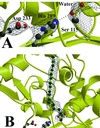The crystal structure of palmitoyl protein thioesterase 1 and the molecular basis of infantile neuronal ceroid lipofuscinosis
- PMID: 10781062
- PMCID: PMC18274
- DOI: 10.1073/pnas.080508097
The crystal structure of palmitoyl protein thioesterase 1 and the molecular basis of infantile neuronal ceroid lipofuscinosis
Abstract
Mutations in palmitoyl-protein thioesterase 1 (PPT1), a lysosomal enzyme that removes fatty acyl groups from cysteine residues in modified proteins, cause the fatal inherited neurodegenerative disorder infantile neuronal ceroid lipofuscinosis. The accumulation of undigested substrates leads to the formation of neuronal storage bodies that are associated with the clinical symptoms. Less severe forms of PPT1 deficiency have been found recently that are caused by a distinct set of PPT1 mutations, some of which retain a small amount of thioesterase activity. We have determined the crystal structure of PPT1 with and without bound palmitate by using multiwavelength anomalous diffraction phasing. The structure reveals an alpha/beta-hydrolase fold with a catalytic triad composed of Ser115-His289-Asp233 and provides insights into the structural basis for the phenotypes associated with PPT1 mutations.
Figures





References
-
- Santavuori P, Haltia M, Rapola J. Dev Med Child Neurol. 1974;16:644–653. - PubMed
-
- Vesa J, Hellsten E, Verkruyse L A, Camp L A, Rapola J, Santavuori P, Hofmann S L, Peltonen L. Nature (London) 1995;376:584–587. - PubMed
-
- Hellsten E, Vesa J, Speer M C, Makela T P, Jarvela I, Alitalo K, Ott J, Peltonen L. Genomics. 1993;16:720–725. - PubMed
-
- Hofmann S L, Das A K, Yi W, Lu J-Y, Wisniewski K E. Mol Genet Metab. 1999;66:234–239. - PubMed
-
- Verkruyse L A, Hofmann S L. J Biol Chem. 1996;271:15831–15836. - PubMed
Publication types
MeSH terms
Substances
Associated data
- Actions
- Actions
Grants and funding
LinkOut - more resources
Full Text Sources
Other Literature Sources
Molecular Biology Databases

